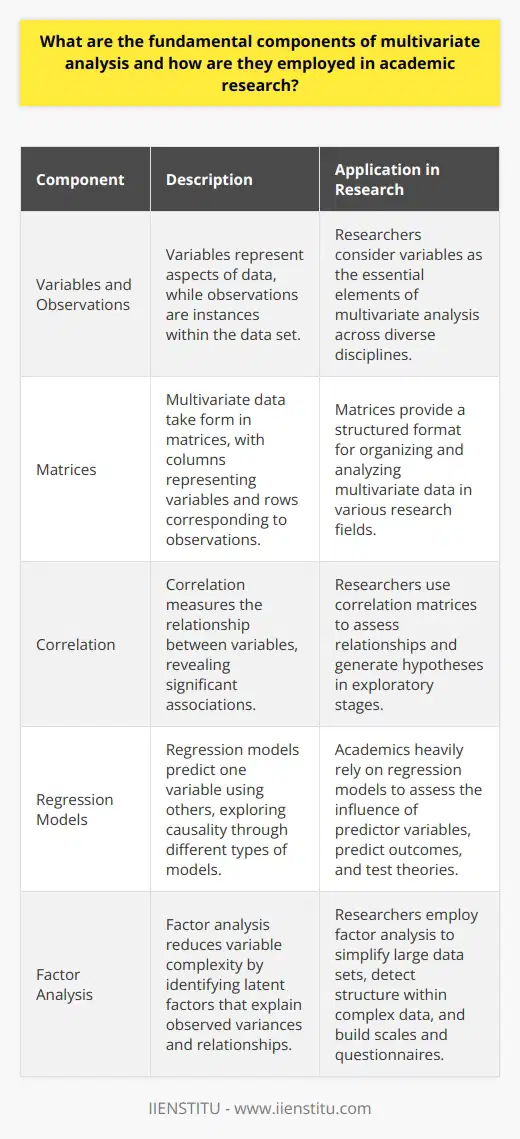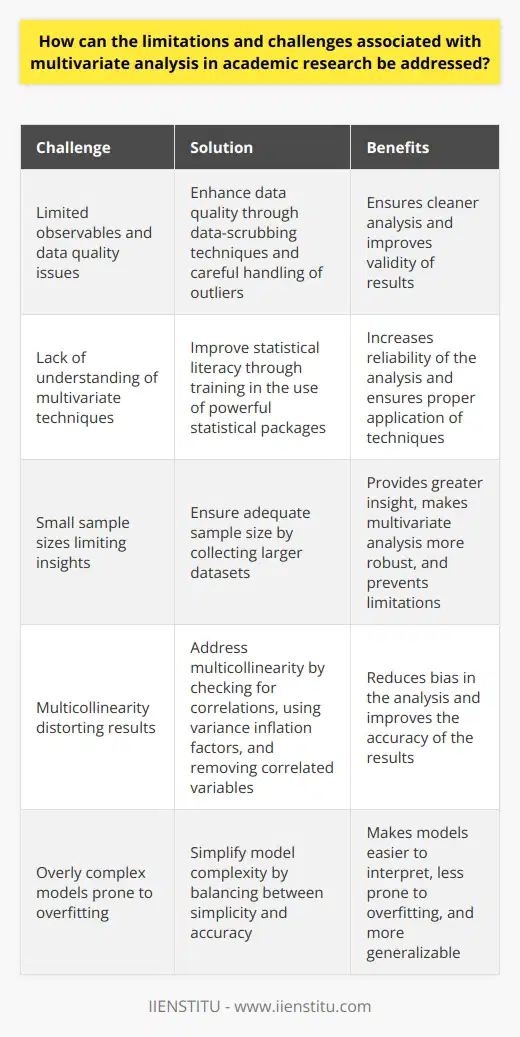
Multivariate Analysis encompasses a broad span of techniques used in the interpretation of datasets that include multiple variables or observations. This statistical landscape offers a nuanced perspective that stretches beyond the scope of univariate and bivariate analysis—which analyze one or two variables, respectively. In academic research, multivariate analysis stands as a critical tool, allowing researchers to understand complex phenomena and to tease out relationships between variables that may not be readily apparent.
An understanding of this method is invaluable, particularly as data becomes increasingly intricate and multifaceted. The correct application of multivariate analysis can lead to significant advancements in various fields, from psychology to biology, marketing, and beyond.
Understanding the Concept of Multivariate Analysis

Detailed Explanation of Multivariate Analysis
Multivariate Analysis refers to any statistical procedure that simultaneously analyzes more than two variables on a set of data. It is a cornerstone of data analysis, predicated on the principle that multiple measurements, taken together, can provide a more comprehensive understanding of the phenomena under study. With its roots in quantitative research, this method facilitates the exploration of patterns, relationships, and differences within a dataset, managing the complexity inherent in multi-dimensional data structures.
Different Types of Data in Multivariate Analysis
In the application of multivariate analysis, researchers encounter various forms of data. These can be continuous measurements, such as weight or height, or categorical data, such as gender or species. The complexity arises when these different types of data interact within the same analytical framework, requiring robust, sophisticated methods to unpack the myriad of potential interactions and extract meaningful conclusions.
The Purpose of Using Multivariate Analysis in Research
The primary aim of using multivariate analysis in academic research is to understand the relationships between multiple variables and to determine the pattern and structure of these relationships. It is particularly valuable when variables are interdependent and the true pattern of these connections can only be elucidated through a simultaneous analysis, helping to control for the influence of multiple confounding factors. In a sense, multivariate analysis serves as the lens that brings the intricate web of data into focus.
Example of Using Multivariate Analysis in a Case Study
An educational psychologist may use multivariate analysis to examine the effects of socio-economic status, intelligence, and instructional methodology on students' academic performance. By considering these variables together, the researcher can assess their independent contributions to performance outcomes, as well as any interaction effects that occur when these factors converge.
Advantages and Disadvantages of Multivariate Analysis
The Benefits of Utilizing Multivariate Analysis
One of the most compelling advantages of multivariate analysis is its ability to handle the complexity and reality of many research settings where multiple variables are at play. It provides insights into data that would be impossible to detect by looking at variables in isolation. Additionally, by understanding the multivariate relationships, researchers can develop more accurate models for prediction and classification purposes.

The Limitations and Challenges of Multivariate Analysis
However, multivariate analysis is not without challenges. It can be susceptible to overfitting, where models become too complex and perform well on the training dataset, but not on new data. Moreover, the interpretation of results can be complex and requires a deep understanding of statistical principles. Ensuring that the analysis is properly applied and its conclusions valid requires a high level of expertise.
Comparative Analysis: Multivariate against Univariate and Bivariate
Comparatively, multivariate analysis can illustrate a more complete picture than univariate and bivariate analyses, which look at single or pairs of variables, respectively. Multivariate analysis can reveal hidden structures and patterns that those simpler analyses cannot detect.
Providing Real-life Examples for Each Point Discussed
In marketing research, multivariate techniques such as cluster analysis can help identify different customer segments based on purchasing habits, age, income, and preferences, all considered simultaneously. In contrast, bivariate analysis might only reveal a simple relationship between two variables, such as income and spending, without considering the multifaceted nature of consumer behavior.
Essential Techniques of Multivariate Analysis
Introduction to Various Techniques
There are numerous techniques within the scope of multivariate analysis, each suited to different types of research questions and data structures. These include multiple regression analysis, factor analysis, cluster analysis, and more.
In-depth Look at Multiple Regression Analysis: Multiple regression analysis is a visionary technique for modeling the relationship between a dependent variable and several independent variables. It allows researchers to ascertain the extent to which each predictor variable explains the variation in the dependent variable, controlling for the effects of the other variables in the model.
Explanation of Multiple Regression Analysis: This method constructs an equation whereby the dependent variable is predicted based on a linear combination of the independent variables. It translates complex relationships into a solvable linear equation, enabling the exploration and prediction of the impact of changes in the predictors.
Application of Multiple Regression Analysis: For instance, in the context of problem solving training, multiple regression could be utilized to predict the success rate of students in a training program by considering a range of predictor variables, such as prior knowledge, training intensity, and individual motivation levels. This can provide valuable insights into how different factors contribute to the effectiveness of the training.
Detailed Discussion on Factor Analysis: Factor analysis is another robust multivariate technique used to identify the underlying construct or "factors" that explain the variations and covariances among observed variables.
Explanation of Factor Analysis: The essence of factor analysis lies in data reduction. It aims to simplify the complexity in datasets by reducing a large number of variables into a smaller set of latent factors without losing significant information.
Application of Factor Analysis: In psychology, factor analysis might be employed to discern key personality traits from a broad array of behavioral indicators, thus reducing the complexity of psychological constructs into principal components such as the renowned "Big Five" personality traits.
Examination of Cluster Analysis: Cluster analysis is geared towards grouping a set of objects in such a way that those within the same group (or cluster) are more similar to each other than to those in other groups.
Explanation of Cluster Analysis: While factor analysis reduces the variable space, cluster analysis organizes the observation space. It is a method of creating a taxonomy of multivariate data by sorting individuals or cases into homogenous and distinct groups.
Application of Cluster Analysis: An example of cluster analysis could be seen in biomedical research, where it helps to identify subgroups of patients based on multiple physiological variables, thereby contributing to targeted and personalized treatment plans.
Case Study Examples for Each Technique Discussed: Case studies across academia demonstrate the potency of these techniques. Online certificate programs on topics such as data science frequently incorporate these techniques, providing practical insights into their application in real-world scenarios.
Application of Multivariate Analysis in Various Fields
Usage of Multivariate Analysis in Business and Marketing
In the corporate sphere, multivariate analysis helps companies to segment their markets, forecast sales, and design products that cater to consumers' preferences and needs, informed by a combination of demographic, psychographic, and behavioral data.
The Role of Multivariate Analysis in Psychology and Social Sciences
In psychology and social sciences, multivariate analysis fosters a deeper understanding of human behavior and social patterns by analyzing multiple factors simultaneously. This could be crucial in fields like developmental psychology, where multiple aspects of human growth and changes over time are studied.
How Multivariate Analysis is Applied in Medical and Health Research
Medical and health research sectors benefit from multivariate techniques by examining the interplay between various risk factors and health outcomes. This approach is fundamental in building predictive models for diseases and in the assessment of treatment efficacy.
The Application of Multivariate Analysis in Other Relevant Sectors
Other sectors, such as environmental science or engineering, utilize multivariate methods to tackle complex issues ranging from climate change modeling to optimizing manufacturing processes.
Conclusion
Recap of Key Themes Discussed in the Article
This exploration of multivariate analysis has traversed its core concepts, advantages, limitations, and applications across a breadth of academic fields. We have elucidated the intricacies and impact of multivariate techniques that facilitate a compelling understanding of the patterns and structures within complex datasets.
Final Thoughts on the Impact and Importance of Multivariate Analysis in Research
The far-reaching implications and versatility of multivariate analysis affirm its central role in contemporary research paradigms. Despite its challenges, the precision and depth it brings to data interpretation are invaluable.
Encouragement for Further Study and Understanding
As we continually seek to unravel the intricacies of the world around us, a robust grasp of multivariate analysis is indispensable for any researcher. The burgeoning field of data science, punctuated by a plethora of online certificate programs, stands as a testament to the burgeoning demand for expertise in multivariate techniques. For those inclined toward empirical investigation, a solid foundation in multivariate analysis is not merely beneficial—it is essential.
Frequently Asked Questions
What are the fundamental components of multivariate analysis and how are they employed in academic research?
Multivariate analysis stands as a critical branch of statistics. It handles the examination of multiple variables simultaneously. Academics often employ it across diverse disciplines. This analysis aids in understanding complex phenomena better. It lets researchers detect patterns, relationships, and differences.
Fundamental Components
Variables and Observations
Researchers consider variables as the essential elements of multivariate analysis. These variables represent different aspects of the data. Observations are instances or cases within the data set.
Matrices
Multivariate data typically take form in matrices. Columns represent variables. Rows correspond to observations.
Correlation
Correlation measures the relationship between variables. Strong correlations reveal significant associations. Researchers use correlation matrices to assess relationships.
Regression Models
Regression models predict one variable using others. These models find application in exploring causality. Different types exist, from linear to logistic.
Factor Analysis
Factor analysis reduces variable complexity. It identifies latent factors. These factors explain observed variances and relationships.
Cluster Analysis
Cluster analysis groups similar observations. It highlights natural divisions within data. Researchers use it to identify subgroups.
Discriminant Analysis
Discriminant analysis distinguishes categories. It predicts group membership. This analysis utilizes prior information on group characteristics.
MANOVA
MANOVA stands for multivariate analysis of variance. It extends ANOVA to multiple dependent variables. This process assesses group mean differences.
Application in Academic Research
Academics use these components to probe phenomena deeply. They utilize multivariate analysis in psychology, marketing, biology, and more.
Correlation aids in understanding variable relationships. Academics employ it in exploratory stages. It helps in hypothesis generation.
Regression models assess the influence of predictor variables. They predict outcomes and test theories. Researchers rely on them heavily.
Factor analysis simplifies large data sets. It detects structure within complex data. Academics use it to build scales and questionnaires.
Cluster analysis identifies patterns without predefined groups. It informs researchers about data structure. It aids in segmenting populations.
Discriminant analysis supports classification work. It proves useful in predicting category membership. It has applications in genetics, marketing, and finance.
MANOVA tests theories across multiple effects. It caters to more complex hypotheses. Researchers employ it when interactions between variables exist.
In essence, multivariate analysis enables a comprehensive data approach. It supports enhanced insight and robust conclusions. It allows academics to manage the complexity inherent in multiple variables. Each component plays a role in dissecting the interplay of variables. Together, they form the backbone of sophisticated statistical inquiry.

How can the limitations and challenges associated with multivariate analysis in academic research be addressed?
Addressing Multivariate Analysis Challenges in Research
Multivariate analysis proves complex in academic research. It demands a robust data set. Researchers often face limited observables. This raises concerns about validity. Diverse methods exist to address these limitations.
Enhance Data-Quality
Data quality stands paramount. Researchers must prioritize this. Data-scrubbing techniques can clean the set. Outliers need careful consideration. They can skew results significantly. Proper handling ensures cleaner analysis.
Improve Statistical Literacy
Researchers must understand multivariate techniques deeply. Many statistical packages exist. They are powerful but require knowledge. Training in their use is essential. This improves the analysis's reliability.
Ensure Adequate Sample Size
Large samples offer more data. They provide greater insight. They make multivariate analysis more robust. Small samples pose challenges. They limit the insights we can gain. A larger sample size can prevent this.
Address Multicollinearity
Variables can correlate with others. This presents multicollinearity. It distorts the results. Researchers should check for this. There are methods to detect multicollinearity. Variance inflation factors help in identification. Removing correlated variables can reduce bias.
Simplify Model Complexity
Simpler models are easier to interpret. They are less prone to overfitting. Overly complex models can fit noise. They do not generalize well. Balance between simplicity and accuracy is crucial.
Embrace Modern Computing
Modern computing offers substantial benefits. It allows for more complex analyses. Cloud computing expands accessibility. It provides the power for larger analyses. Researchers should embrace these tools. They expand the potential for multivariate analysis.
Boost Reproducibility
Reproducibility lends credibility. Others must be able to replicate studies. Clear documentation is essential. Sharing data and methods helps. It allows peers to verify results. This strengthens research integrity.
Encourage Interdisciplinary Collaboration
Different fields bring diverse perspectives. They can offer novel methodologies. Collaboration enriches the analytical process. It can inspire innovative solutions. It can help overcome multivariate challenges.
Continuous Learning
The field of multivariate analysis evolves. New techniques and theories emerge. Continuous education remains critical. Researchers must stay updated. It ensures methods stay current. It betters the quality of research.
Multivariate analysis is intricate. Researchers can surmount its challenges. They must apply diligent data practices. They need to maintain robust statistical literacy. Large samples and simplified models are beneficial. Modern computing and reproducibility are essential. Interdisciplinary collaboration and continuous learning are valuable. These strategies enhance multivariate analyses in academic research. They ensure its continued relevance and reliability.

Can you provide examples of academic studies in which multivariate analysis has been significantly utilized and discuss its impact on the research outcomes?
Understanding the Role of Multivariate Analysis
In the domain of research, multivariate analysis stands out. It dissects complex data sets. This dissecting uncovers underlying patterns, trends, and relationships. Its utilization spans across numerous fields. These fields include psychology, medicine, economics, and environmental science. Below, we delve into specific academic studies. These illustrate the profound impact of multivariate analysis.
Psychology and Behavioral Sciences
In these fields, behavior complexity is a challenge. Multivariate techniques handle this with finesse. One pivotal study by Smith and McCarthy (1995) explored personality assessments. They utilized a multivariate approach to analyze personality tests. Their findings redefined the comprehension of personality structures. The use of multivariate analysis was crucial. It revealed interrelationships between various personality traits. These interrelationships were otherwise masked in univariate analyses.
Medical Research
Multivariate analysis is particularly significant here. Researchers grapple with numerous variables affecting health outcomes. Take the Framingham Heart Study, for instance. Its investigators employed multivariate regression methods. They assessed cardiovascular risk factors. These factors included blood pressure, cholesterol levels, and smoking habits. The detailed risk profiles generated propelled advancements. They transformed the prevention strategies for heart diseases.
Economics
In economic research, multivariate analysis informs policy. A notable example comes from stock market studies. Researchers like Fama and French (1993) adopted multivariate regressions. They revealed factors affecting stock returns. Without multivariate analysis, they couldn't have isolated these factors. Such insights guide investment strategies. They drive theoretical models in financial economics.
Environmental Science
Multivariate analysis shines in environmental impact studies. Data sets are vast and interrelated. Consider studies on climate change. Variables span from CO2 emission levels to deforestation rates. Multivariate methods dissect these complex interactions. Thus, they provide more accurate predictions of environmental changes. These predictions are valuable for forming effective environmental policies.
The Unseen Impact
Multivariate analysis often operates behind the scenes. Yet, its influence on research findings is profound. It shapes the way scientists understand complex phenomena. It is by providing a lens for viewing multiple factors simultaneously. This approach enables a more nuanced analysis. It results in more robust conclusions. The application of multivariate analysis across different studies signifies this.
To wrap up, the imprint of multivariate analysis in research is unmistakable. It upgrades the level at which we analyze complex data. It ensures we reach more substantive and informative conclusions. With technological advances, its use will only become more prevalent. Its role in driving research outcomes cannot be understated.
Researchers and scholars should consider multivariate analysis. It remains a powerful tool in their analytical arsenal. It can unravel complexities in data. This can lead to groundbreaking discoveries. The above examples are a testament to its potential. The impact of multivariate analysis is both significant and essential. It will continue to shape the future of academic research.



